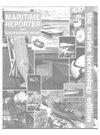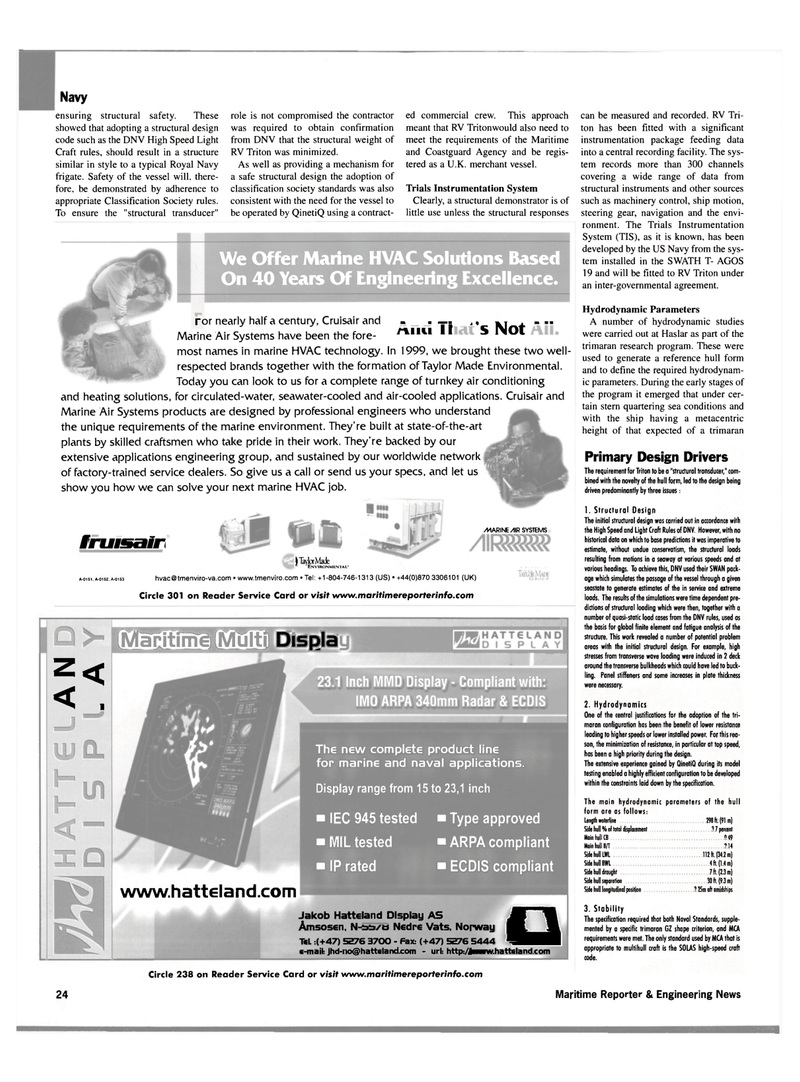
Page 24: of Maritime Reporter Magazine (September 2002)
Read this page in Pdf, Flash or Html5 edition of September 2002 Maritime Reporter Magazine
Navy ensuring structural safety. These showed that adopting a structural design code such as the DNV High Speed Light
Craft rules, should result in a structure similar in style to a typical Royal Navy frigate. Safety of the vessel will, there- fore, be demonstrated by adherence to appropriate Classification Society rules.
To ensure the "structural transducer" role is not compromised the contractor was required to obtain confirmation from DNV that the structural weight of
RV Triton was minimized.
As well as providing a mechanism for a safe structural design the adoption of classification society standards was also consistent with the need for the vessel to be operated by QinetiQ using a contract- ed commercial crew. This approach meant that RV Tritonwould also need to meet the requirements of the Maritime and Coastguard Agency and be regis- tered as a U.K. merchant vessel.
Trials Instrumentation System
Clearly, a structural demonstrator is of little use unless the structural responses
We Offer Marine HVAC Solutions Based
On 40 Years Of Engineering Excellence.
Iruisair | Taylor Made v Fvvinnvu /MARINE/IIR SYSTEMS
Environmental- a-0151. a-0152. A-0153 [email protected] • www.tmenviro.com • Tel: +1-804-746-1313 (US) • +44(0)870 3306101 (UK) ror nearly half a century, Cruisair and . —. , ...
Marine Air Systems have been the fore- " "S NOt most names in marine HVAC technology. In 1999, we brought these two well- respected brands together with the formation of Taylor Made Environmental.
Today you can look to us for a complete range of turnkey air conditioning and heating solutions, for circulated-water, seawater-cooled and air-cooled applications. Cruisair and
Marine Air Systems products are designed by professional engineers who understand the unique requirements of the marine environment. They're built at state-of-the-art plants by skilled craftsmen who take pride in their work. They're backed by our extensive applications engineering group, and sustained by our worldwide network of factory-trained service dealers. So give us a call or send us your specs, and let us show you how we can solve your next marine HVAC job.
Circle 301 on Reader Service Card or visit www.maritimereporterinfo.com z< < . (gLBjffifTilj fgfcfff)
Displa 23.1 Inch MMD Display - Compliant with:
IMO ARPA 340mm Radar & ECDIS
The new complete product line for marine and naval applications.
Display range from 15 to 23,1 inch • IEC 945 tested • Type approved • MIL tested "ARPA compliant • IP rated • ECDIS compliant www.hatteland.com
Jakob Hatteland Display AS
Amsosen, N-5578 Nedre Vats, Norway
TEL :(+47) 5276 3700 - Fax: (+47) 5276 5444
E-maik [email protected] - url: http://www.hattEland.com a 3ttEland.co
Circle 238 on Reader Service Card or visit www.maritimereporterinfo.com can be measured and recorded. RV Tri- ton has been fitted with a significant instrumentation package feeding data into a central recording facility. The sys- tem records more than 300 channels covering a wide range of data from structural instruments and other sources such as machinery control, ship motion, steering gear, navigation and the envi- ronment. The Trials Instrumentation
System (TIS), as it is known, has been developed by the US Navy from the sys- tem installed in the SWATH T- AGOS 19 and will be fitted to RV Triton under an inter-governmental agreement.
Hydrodynamic Parameters
A number of hydrodynamic studies were carried out at Haslar as part of the trimaran research program. These were used to generate a reference hull form and to define the required hydrodynam- ic parameters. During the early stages of the program it emerged that under cer- tain stern quartering sea conditions and with the ship having a metacentric height of that expected of a trimaran
Primary Design Drivers
The requirement for Triton to be a "structural transducer," com- bined with the novelty of the hull form, led to the design being driven predominantly by three issues: 1. Structural Design
The initial structural design was carried out in accordance with the High Speed and Light Craft Rules of DNV. However, with no historical data on which to base predictions it was imperative to estimate, without undue conservatism, the structural loads resulting from motions in a seaway at various speeds and at various headings. To achieve this, DNV used their SWAN pack- age which simulates the passage of the vessel through a given seastate to generate estimates of the in service and extreme loads. The results of the simulations were time dependent pre- dictions of structural loading which were then, together with a number of quasi-static load cases from the DNV rules, used as the basis for global finite element and fatigue analysis of the structure. This work revealed a number of potential problem areas with the initial structural design. For example, high stresses from transverse wave loading were induced in 2 deck around the transverse bulkheads which could have led to buck- ling. Panel stiffeners and some increases in plate thickness were necessary. 2. Hydrodynamics
One of the central justifications for the adoption of the tri- maran configuration has been the benefit of lower resistance leading to higher speeds or lower installed power. For this rea- son, the minimization of resistance, in particular at top speed, has been a high priority during the design.
The extensive experience gained by QinetiQ during its model testing enabled a highly efficient configuration to be developed within the constraints laid down by the specification.
The main hydrodynamic parameters of the hull form are as follows:
Length woteriine 298 ft. (91 m)
Side hull % of total displacement 3.7 peicent
Main hull CB 0.49
Main hull B/T 2.14
Side hull LWL 112 It. (34.2 m)
Side hull SWL 4 ft. (1.4 m)
Side hull draught 7 ft. (2.3 m)
Side hull separation 30 fl. (9.3 m)
Side hull longitudinal position 2.25m ah amidships 3. Stability
The specification required thot both Naval Standards, supple- mented by a specific trimaran GZ shape criterion, and MCA requirements were met. The only standard used by MCA that is appropriate to multihull craft is the SOUS high-speed craft code. 24 Maritime Reporter & Engineering News

 23
23

 25
25
